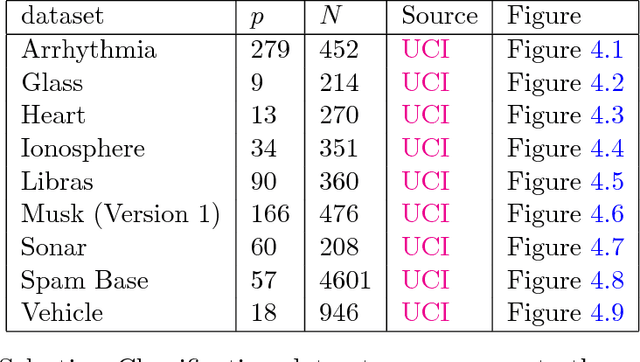Vural Aksakalli
SPSA-FSR: Simultaneous Perturbation Stochastic Approximation for Feature Selection and Ranking
Apr 16, 2018



Abstract:This manuscript presents the following: (1) an improved version of the Binary Simultaneous Perturbation Stochastic Approximation (SPSA) Method for feature selection in machine learning (Aksakalli and Malekipirbazari, Pattern Recognition Letters, Vol. 75, 2016) based on non-monotone iteration gains computed via the Barzilai and Borwein (BB) method, (2) its adaptation for feature ranking, and (3) comparison against popular methods on public benchmark datasets. The improved method, which we call SPSA-FSR, dramatically reduces the number of iterations required for convergence without impacting solution quality. SPSA-FSR can be used for feature ranking and feature selection both for classification and regression problems. After a review of the current state-of-the-art, we discuss our improvements in detail and present three sets of computational experiments: (1) comparison of SPSA-FS as a (wrapper) feature selection method against sequential methods as well as genetic algorithms, (2) comparison of SPSA-FS as a feature ranking method in a classification setting against random forest importance, chi-squared, and information main methods, and (3) comparison of SPSA-FS as a feature ranking method in a regression setting against minimum redundancy maximum relevance (MRMR), RELIEF, and linear correlation methods. The number of features in the datasets we use range from a few dozens to a few thousands. Our results indicate that SPSA-FS converges to a good feature set in no more than 100 iterations and therefore it is quite fast for a wrapper method. SPSA-FS also outperforms popular feature selection as well as feature ranking methods in majority of test cases, sometimes by a large margin, and it stands as a promising new feature selection and ranking method.
Feature Selection via Binary Simultaneous Perturbation Stochastic Approximation
Mar 05, 2016



Abstract:Feature selection (FS) has become an indispensable task in dealing with today's highly complex pattern recognition problems with massive number of features. In this study, we propose a new wrapper approach for FS based on binary simultaneous perturbation stochastic approximation (BSPSA). This pseudo-gradient descent stochastic algorithm starts with an initial feature vector and moves toward the optimal feature vector via successive iterations. In each iteration, the current feature vector's individual components are perturbed simultaneously by random offsets from a qualified probability distribution. We present computational experiments on datasets with numbers of features ranging from a few dozens to thousands using three widely-used classifiers as wrappers: nearest neighbor, decision tree, and linear support vector machine. We compare our methodology against the full set of features as well as a binary genetic algorithm and sequential FS methods using cross-validated classification error rate and AUC as the performance criteria. Our results indicate that features selected by BSPSA compare favorably to alternative methods in general and BSPSA can yield superior feature sets for datasets with tens of thousands of features by examining an extremely small fraction of the solution space. We are not aware of any other wrapper FS methods that are computationally feasible with good convergence properties for such large datasets.
 Add to Chrome
Add to Chrome Add to Firefox
Add to Firefox Add to Edge
Add to Edge